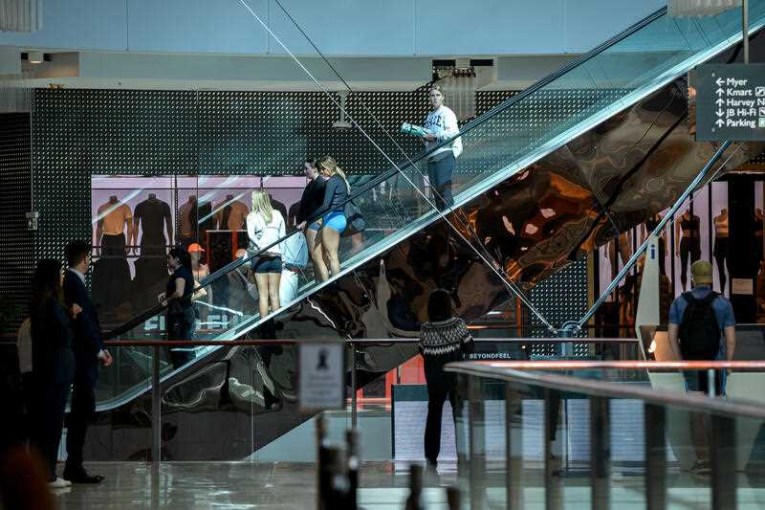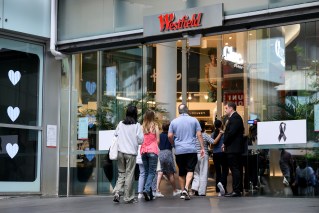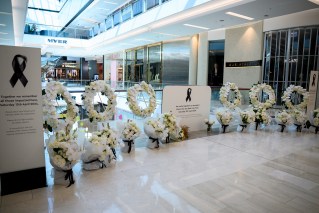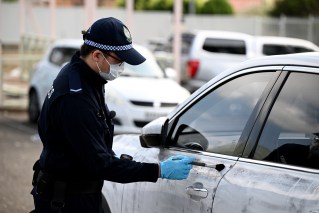NSW Police pushed for Black Lives Matter mural on private property in Redfern to be removed
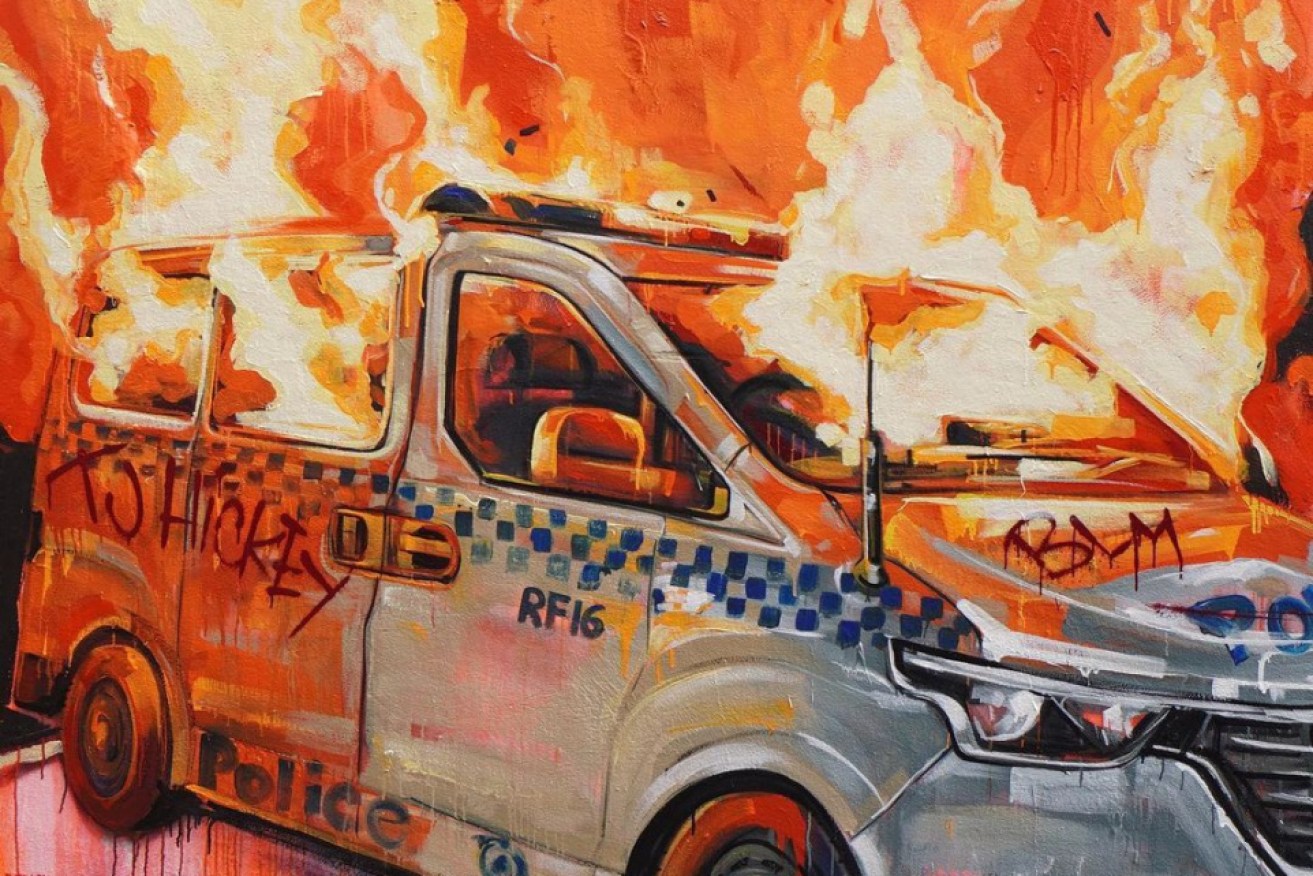
Artist Scott Marsh believes he has been censored by police after officers called the City of Sydney asking for this mural to be removed. Photo: Instagram/@ScottieMarsh
At the height of the Black Lives Matter protests last year, NSW Police made multiple calls over a 24-hour period to instruct the City of Sydney to remove a Black Lives Matter mural depicting a burning police car.
A warning to Indigenous readers, the following story contains the name of an Indigenous person who has died.
New audio recordings obtained by ABC News Breakfast reveal New South Wales police officers called the City of Sydney at least four times in a 24-hour period beginning on June 22 last year, asking them to remove the Black Lives Matter-inspired mural.
The mural, painted on private property in Glover Lane in the inner-city suburb of Redfern, was created last June by artist Scott Marsh.
But it was removed within a day after requests from NSW Police to the City of Sydney.
The mural showed a police car on fire with the name “TJ Hickey” written on the side.
The death of 17-year-old TJ Hickey sparked the Redfern riots in 2004.
In the audio recordings, police officers indicated they were under pressure from their superiors to get the mural removed.
“This is gonna cause some pretty significant issues and I’ve got a lot of interest from above,” a NSW police officer said.
A City of Sydney spokesperson said the calls obtained by the ABC were made to their public customer service line.
When asked whether the mural had “racist or foul language” by a council customer service representative, a NSW police officer responded: “It’s got ra… it’s a police car that’s on fire.”
“But it’s got, it’s got things about Aboriginals written on it. It’s got things about Black Lives Matter on it. And people are finding it incredibly offensive.”
The officers told the customer service team they had an “unmarked police vehicle” sitting near the mural.
“We’re worried it’s going to attract media attention very soon. That’s why we need it done ASAP.”
In a separate call, another officer reiterated that police had officers sitting waiting for graffiti removalists.
With the mural still not removed hours after the first call, police officers again said they had been waiting for the removalists to take down the mural.
“We’ve been trying all morning to get a mural painted over or removed. This is about my fourth phone call. And I’ve been told they’re going to get a car crew down there since 4:00am. And we still got no-one on-site,” an officer said in the recordings.
The mural was removed on June 23. Mr Marsh posted a video of police watching it being painted over on his Instagram account.
Mr Marsh believes he has been censored by NSW Police. He said the police should not have the power to “destroy legal artworks created on private property”.
“If the police had left the mural alone, it would not have received national attention back then and we wouldn’t be speaking about it now,” Mr Marsh said.
In a statement, a spokesperson for the NSW Police Force said officers from South Sydney Police Area Command were made aware of an anti-police mural painted on a Redfern building after receiving several complaints from the community on June 22, 2020.
“Police spoke with the building owner and referred the matter to local council, as is standard protocol.”
“It is not unusual for police to request council remove unauthorised or offensive wall paintings in response to concerns raised by members of the public.”
In a statement, a spokesperson for the City of Sydney said the council removed the mural after requests from NSW Police.
“NSW Police asked us to remove the mural, citing a request by the owner and community concerns,” the spokesperson said.
“The City strives to strike a balance between minimising the incidents of graffiti on public and private property by prompt removal while providing legitimate avenues for the expression of community information and art.”

NSW Police say is it is not unusual for them to ask the City of Sydney to remove offensive wall paintings. Photo: AAP
‘I was shocked,’ says mother of TJ Hickey
A coronal inquest found TJ Hickey’s death was a “freak accident” and police were not responsible, but his family disagree with the findings.
The teenager was killed when he lost control of his bicycle and became impaled on a fence next to Redfern Park.
The incident sparked a nine-hour riot in which the Redfern railway station was set on fire and police were pelted with rocks, bricks and bottles, leaving more than 40 officers injured.
Mr Hickey’s family believe he was being chased by a police car when he died
His mother, Gail Hickey, said in a statement she was “shocked” when she saw NSW Police had asked for the mural to be removed.
“How many Aboriginal people have to die at the hands of police and in custody before we all say, ‘That is too many deaths and the system we have is broken for Aboriginal people?'”
Mr Marsh painted the mural after seeing an image from the Black Lives Matter protests in New York. The mural was of a New York City police car on fire with “George” spray-painted on it — a reference to George Floyd, who was killed by a police officer one year ago.
“The image actually gave me goosebumps, it was such a potent symbol for all the built-up pain and frustration of a community,” Mr Marsh said.

A Black Lives Matter mural in New York of a burning New York City police car with “George” written on the side. Photo: Instagram/@scottiemarsh
“I wanted to place that symbol within an Australian context, I immediately thought of TJ Hickey and the Redfern riots.”
Expert believes mural didn’t break criminal law
Luke McNamara, co-director of the UNSW Centre for Crime, Law and Justice, told the ABC he believed the mural did not break criminal law.
The mural was painted on a wall on Ambour Hardware after Mr Marsh received approval from the owner, Joe Ambour.
In 2014, the Graffiti Control Act in NSW was reformed to include the consent of the owner as a stipulation to whether paintings, markings and street art on properties or premises were an offence.
“There was a deliberate move by the New South Wales Parliament to make the owner’s consent a critical ingredient in whether or not we regarded the conduct as criminal or not,” Professor McNamara said.

Professor McNamara believes there should be question as to why NSW Police got involved. Photo: Anna Kucera
Professor McNamara said the fact that consent was given for the art to be created in the first place raised a “huge question” as to whether there was anything criminal about the behaviour.
“I think we’ve got a question why the police thought it was fit to involve themselves in a street art installation.”
After the mural was removed last year, Mr Ambour said he was asked to sign a statement by NSW Police to prevent Mr Marsh from using his property to paint any future artwork.
“He said give [your wall] to anybody else, it’s your wall but we don’t want any trouble. But give it to anybody else except Scott Marsh. So anyone can paint something, like artists painting, but not Scott Marsh — simple as that.”
“I said, Yeah, OK. I didn’t want any trouble, I just signed it.”
Mr Ambour said he wasn’t coerced or forced to sign the statement, but that police had told him the mural would lead to violence.

Joe Ambour says police asked him to sign this written statement saying he would not allow Scott Marsh to paint on his property again. Photo: Supplied
Associate professor Amelia Thorpe, who specialises in planning, property and local government law, said the City of Sydney had a more expansive definition when it came to graffiti policy.
Street artists must seek approval from both the property’s owner and the City of Sydney, she explained.

Amelia Thorpe says the mural’s removal was in accordance with the City of Sydney’s anti-graffiti policy. Photo: Supplied/Dr Amelia Thorpe
However, under the city’s environmental plan, street art is exempt from developmental approval if it is not advertising a business, is not painted on a heritage conservation area, or does not contain material that is offensive, sexually explicit or discriminatory.
“So there’s a very interesting dynamic there when the city says that it’s supportive of street art but it’s really willing to go and paint over it,” Dr Thorpe said.
“This is certainly not the only example that I know of; there are other cases where this has happened. And it fits in with the city’s graffiti removal policy.”
–ABC
